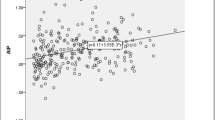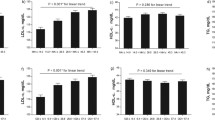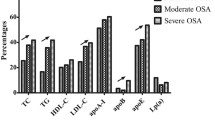Abstract
Background
Lipid metabolism disorder is recognized to be associated with obstructive sleep apnea (OSA); however, inconsistent results have been reported. The aim of this study was to evaluate the association between lipid profile and OSA with adjustments for multiple confounding factors.
Methods
In total, 2983 subjects were recruited from the Shanghai Sleep Health Study (SSHS) during 2007–2013. Data for overnight polysomnography (PSG) parameters, serum lipids, fasting blood glucose, insulin levels, and anthropometric measurements were collected. Multivariable logistic regression analyses were used to determine the correlation between lipid profile and OSA with adjustments for confounders including lipids, age, gender, Epworth sleepiness scale, body mass index, waist/hip ratio, glucose, insulin resistance, hypertension, and smoking.
Results
The prevalence of hyper total cholesterol (TC), hyper triglycerides, hypo high-density lipoprotein cholesterol, hyper low-density lipoprotein cholesterol (LDL-C), hyper apolipoprotein (apo) A-I, and hyper apoB differed significantly between the non-OSA and OSA patients. Without considering the interaction across different lipids, TC, LDL-C, and apoB were independently associated with OSA in primary multivariable logistic regression analyses; the odds ratios (ORs) and 95 % confidence intervals (CIs) were 1.262 (1.109–1.438), 1.432 (1.233–1.664), and 5.582 (2.643–11.787), respectively. However, only LDL-C (OR = 1.430, 95 % CI = 1.221–1.675) was found to be an independent risk factor for OSA in further multivariable logistic regression analyses.
Conclusions
We demonstrated that patients with OSA had a higher percentage of dyslipidemia than subjects without OSA. Of the various components in serum lipid, only LDL-C was independently associated with OSA.
Similar content being viewed by others
References
Young T, Palta M, Dempsey J, Skatrud J, Weber S et al (1993) The occurrence of sleep-disordered breathing among middle-aged adults. N Engl J Med 328:1230–1235
Peppard PE, Young T, Barnet JH, Palta M, Hagen EW et al (2013) Increased prevalence of sleep-disordered breathing in adults. Am J Epidemiol 177:1006–1014
Bradley TD, Floras JS (2009) Obstructive sleep apnoea and its cardiovascular consequences. Lancet 373:82–93
Lavie L, Lavie P (2009) Molecular mechanisms of cardiovascular disease in OSAHS: the oxidative stress link. Eur Respir J 33:1467–1484
Baguet JP, Barone-Rochette G, Tamisier R, Levy P, Pepin JL (2012) Mechanisms of cardiac dysfunction in obstructive sleep apnea. Nat Rev Cardiol 9:679–688
Rader DJ, Hovingh GK (2014) HDL and cardiovascular disease. Lancet 384:618–625
Ridker PM (2014) LDL cholesterol: controversies and future therapeutic directions. Lancet 384:607–617
Nordestgaard BG, Varbo A (2014) Triglycerides and cardiovascular disease. Lancet 384:626–635
Toyama Y, Chin K, Chihara Y, Takegami M, Takahashi K et al (2013) Association between sleep apnea, sleep duration, and serum lipid profile in an urban, male, working population in Japan. Chest 143:720–728
Trzepizur W, Le Vaillant M, Meslier N, Pigeanne T, Masson P et al (2013) Independent association between nocturnal intermittent hypoxemia and metabolic dyslipidemia. Chest 143:1584–1589
Togeiro SM, Carneiro G, Ribeiro Filho FF, Zanella MT, Santos-Silva R et al (2013) Consequences of obstructive sleep apnea on metabolic profile: a population-based survey. Obesity (Silver Spring) 21:847–851
Sharma SK, Kumpawat S, Goel A, Banga A, Ramakrishnan L et al (2007) Obesity, and not obstructive sleep apnea, is responsible for metabolic abnormalities in a cohort with sleep-disordered breathing. Sleep Med 8:12–17
Nadeem R, Singh M, Nida M, Waheed I, Khan A et al (2014) Effect of obstructive sleep apnea hypopnea syndrome on lipid profile: a meta-regression analysis. J Clin Sleep Med 10:475–489
Matthews DR, Hosker JP, Rudenski AS, Naylor BA, Treacher DF et al (1985) Homeostasis model assessment: insulin resistance and beta-cell function from fasting plasma glucose and insulin concentrations in man. Diabetologia 28:412–419
Grundy SM, Cleeman JI, Daniels SR, Donato KA, Eckel RH et al (2005) Diagnosis and management of the metabolic syndrome: an American Heart Association/National Heart, Lung, and Blood Institute scientific statement. Circulation 112:2735–2752
Wang C, Hou X, Bao Y, Pan J, Zuo Y et al (2010) The metabolic syndrome increased risk of cardiovascular events in Chinese—a community based study. Int J Cardiol 139:159–165
Peng LL, Li JR, Sun JJ, Li WY, Sun YM et al (2011) Reliability and validity of the simplified Chinese version of Epworth sleepiness scale. Zhonghua Er Bi Yan Hou Tou Jing Wai Ke Za Zhi 46:44–49
Iber C, Ancoli-Israel S, Chesson AL, SF Q (2007) The AASM manual for the scoring of sleep and associated events: rules, terminology and technical specifications for the American Academy of Sleep Medicine. 1st ed. American Academy of Sleep Medicine, Westchester, IL
Togeiro SMCG, Ribeiro Filho FF, Zanella MT, Santos-Silva R, Taddei JA, Bittencourt LR, Tufik S (2013) Consequences of obstructive sleep apnea on metabolic profile: a population-based survey. Obesity (Silver Spring) 21:847–851
Bhattacharjee R, Hakim F, Gozal D (2012) Sleep, sleep-disordered breathing and lipid homeostasis: translational evidence from murine models and children. Clin Lipidol 7:203–214
Can M, Acikgoz S, Mungan G, Bayraktaroglu T, Kocak E et al (2006) Serum cardiovascular risk factors in obstructive sleep apnea. Chest 129:233–237
Coughlin SR, Mawdsley L, Mugarza JA, Calverley PM, Wilding JP (2004) Obstructive sleep apnoea is independently associated with an increased prevalence of metabolic syndrome. Eur Heart J 25:735–741
Tan KC, Chow WS, Lam JC, Lam B, Wong WK et al (2006) HDL dysfunction in obstructive sleep apnea. Atherosclerosis 184:377–382
Michailidis V, Steiropoulos P, Nena E, Papanas N, Maltezos E et al (2011) Continuous positive airway pressure treatment: effect on serum lipids in patients with obstructive sleep apnoea. Open Cardiovasc Med J 5:231–238
McArdle N, Hillman D, Beilin L, Watts G (2007) Metabolic risk factors for vascular disease in obstructive sleep apnea: a matched controlled study. Am J Respir Crit Care Med 175:190–195
Keenan BT, Maislin G, Sunwoo BY, Arnardottir ES, Jackson N et al (2014) Obstructive sleep apnoea treatment and fasting lipids: a comparative effectiveness study. Eur Respir J 44:405–414
Kono M, Tatsumi K, Saibara T, Nakamura A, Tanabe N et al (2007) Obstructive sleep apnea syndrome is associated with some components of metabolic syndrome. Chest 131:1387–1392
Gruber A, Horwood F, Sithole J, Ali NJ, Idris I (2006) Obstructive sleep apnoea is independently associated with the metabolic syndrome but not insulin resistance state. Cardiovasc Diabetol 5:22
Schwartz CJ, Valente AJ, Sprague EA, Kelley JL, Nerem RM (1991) The pathogenesis of atherosclerosis: an overview. Clin Cardiol 14:I1–16
Benn M, Nordestgaard BG, Grande P, Schnohr P, Tybjaerg-Hansen A (2010) PCSK9 R46L, low-density lipoprotein cholesterol levels, and risk of ischemic heart disease: 3 independent studies and meta-analyses. J Am Coll Cardiol 55:2833–2842
Baigent C, Blackwell L, Emberson J, Holland LE, Reith C et al (2010) Efficacy and safety of more intensive lowering of LDL cholesterol: a meta-analysis of data from 170,000 participants in 26 randomised trials. Lancet 376:1670–1681
Acknowledgments
The Shanghai Sleep Health Study Research Group includes Huajun Xu, Jian Guan, Hongliang Yi, Jianyin Zou, Lili Meng, Xulan Tang, Huaming Zhu, Dongzhen Yu, Huiqun Zhou, Kaiming Su, Yue Wang, Jian Wang, and Shankai Yin.
Funding
No funding was received for this research.
Conflict of interest
All authors certify that they have no affiliations with or involvement in any organization or entity with any financial interest (such as honoraria; educational grants; participation in speakers’ bureaus; membership, employment, consultancies, stock ownership, or other equity interest; and expert testimony or patent-licensing arrangements) or non-financial interest (such as personal or professional relationships, affiliations, knowledge or beliefs) in the subject matter or materials discussed in this manuscript.
Ethical approval
All procedures performed in studies involving human participants were in accordance with the ethical standards of the institutional and/or national research committee and with the 1964 Helsinki declaration and its later amendments or comparable ethical standards.
Informed consent
Informed consent was obtained from all individual participants included in the study.
Author information
Authors and Affiliations
Consortia
Corresponding author
Rights and permissions
About this article
Cite this article
Xu, H., Guan, J., Yi, H. et al. Elevated low-density lipoprotein cholesterol is independently associated with obstructive sleep apnea: evidence from a large-scale cross-sectional study. Sleep Breath 20, 627–634 (2016). https://doi.org/10.1007/s11325-015-1262-3
Received:
Revised:
Accepted:
Published:
Issue Date:
DOI: https://doi.org/10.1007/s11325-015-1262-3




